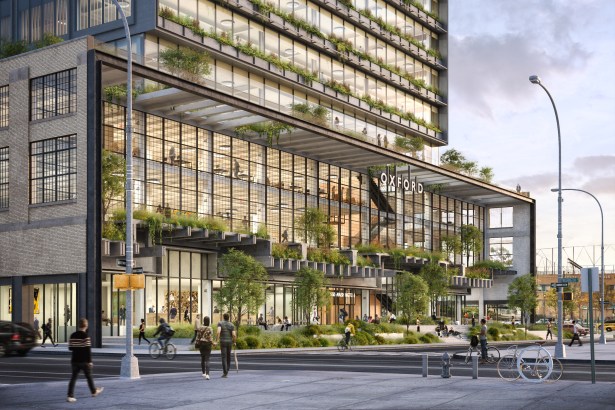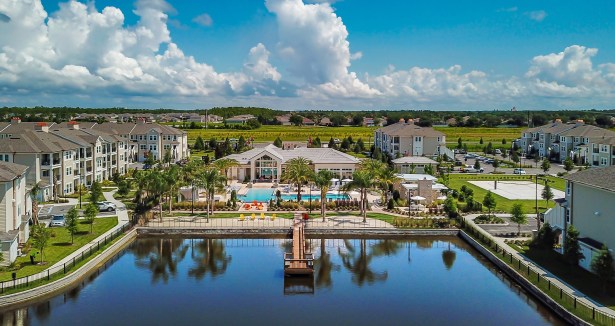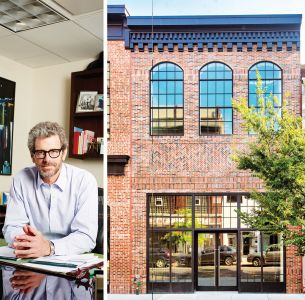O Canada! With China Ghosting American Real Estate, Our Nation Looks North
By Cathy Cunningham March 11, 2019 4:33 pm
reprints
“Wherever you go in the world, you just have to say you’re Canadian and people laugh,” John Candy once reportedly said. But who’s laughing now?
Over the past 18 months, headlines have homed in on China’s tightening capital controls and the subsequent impact on U.S. real estate rather than focusing on the foreign capital sources which are still here and actively investing—namely Japan, Korea, Norway, Germany and Canada. Not to say the industry attention was unwarranted; China’s HNA Group’s spending spree in 2016 and 2017—climaxing in its $2.21 billion purchase of 245 Park Avenue (financed with a $1.8 billion debt package)—was never going to go unnoticed, and neither was its retreat.
So, what aboot the Canadians, eh?
It’s not as if they just jumped into their Zamboni machines and politely offered to fill the void; they’ve been doing this for a long time. In terms of 2018 foreign investment in U.S. commercial real estate, per CBRE (CBRE) data, Canada ranked No. 1, racking up $12.75 billion in individual asset and portfolio sales and a whopping $41.48 billion when you include entity-level transactions, such as Brookfield (BN) Property Partners’ $15 billion acquisition of GGP and Oxford Properties and Ivanhoé Cambridge’s $3.5 billion purchase of Atlanta-based warehouse developer IDI Logistics.
“I wouldn’t say [Canadian investors have] replaced the Chinese,” said Jerome Sanzo, the head of U.S. real estate finance at Industrial and Commercial Bank of China (BACHF). “They were always very active, but you may see Canadian investors much more [clearly] now. For a while I think the Chinese names were new and exotic and got more press.”
That said, “I don’t think Canadian investors are underestimated or under appreciated,” said Richard Barkham, CBRE’s global chief economist. “We’re hugely aware of the surge in Chinese investment that occurred four or five years ago—and the fact that it’s now eased off—but the mature investment professionals in the space have always been aware that Canada provides one of the steadiest sources of capital into U.S. real estate.”
Canada’s real estate market, while robust, is far smaller than the U.S. market. Boosting its outbound capital flow are Canada’s pension funds, bolstered by citizens’ mandatory contributions. As portfolio allocations to real estate increase, their capital is finding a comfortable and familiar investment landing spot in the U.S.—the land of opportunity in more ways than one.
“The U.S. has 10 times the population of Canada [323 million in the U.S. versus 38 million in Canada] and so—broadly speaking—it has 10 times the real estate opportunity that Canada has,” Barkham reasoned.

As such, Canadian investors—feeling yields compress in their local markets—are dominating foreign investment in U.S. real estate, and continuously upping their game.
“We’ve seen some of those groups be more focused on recycling capital away from select Canadian markets and placing it in higher-yielding markets and sectors in the U.S. and Europe,” said Maggie Coleman, a managing director in JLL (JLL)’s international capital group.
“Value-add is the most attractive [investment] strategy and second-tier assets are a close second,” Barkman said of foreign investment trends. Value-add investment strategies have been popular for the past five years or so, he said, adding that—in addition to providing opportunity to reposition assets to fit changing consumer and occupier desires—this might reflect investors wanting to take on more risk but not too much risk, as would be found in a ground-up development.
And Canadian investors of all stripes and strategies are finding plenty of places to park their capital.
“Whether you’re buying industrial parks or office buildings, or apartments like we do, there’s just way more availability of opportunity [in the U.S.],” Raj Mehta, the global head of private capital and partnerships at Toronto-based asset manager Starlight Investments, said of the pull to the U.S. “It’s also a transparent market that’s predominantly broker-led, so you can get access to deal flow and understand where assets are trading relatively easily. I think that gives people a level of comfort.”
Regardless of which market you’re in, you don’t have to look far to see the end result of Canadian investment, from Brookfield Office Properties’ Brookfield Place and Oxford Properties’ Hudson Yards in New York to Omni Group’s acquisition of the L.A. Times Building, Canadian dollars are being put to work.
There’s ample Canadian capital to meet the opportunities the U.S. real estate market presents. For example, Canadian crown corporations Canadian Pension Plan Investment Board (CPPIB) and Public Sector Pension Investment Board (PSP Investment Board) have roughly $521.5 billion in assets under management alone, and Canada has another 10 or so pension funds with over $50 billion in assets under management.
“For a country our size, that’s a lot of capital in the hands of institutional investors, and that’s not even including the insurance companies that are also flush with liquidity,” Mehta said.
Fortuitously, real estate and real assets play an important role in portfolio diversification. “Most of these institutions have around 10 to 20 percent of their overall allocations in real estate, and there just isn’t enough real estate in Canada that you can acquire,” Mehta explained.
Sadly, seeing as, “Canadian real estate has extremely good investment characteristics, and quite a high blend of yield, stability and growth,” Barkman said. “It is extremely attractive as an investment asset class. You see foreign capital wanting to access Canadian real estate, but the pension system is well-funded and there just isn’t enough opportunity.”
In addition to an uptick in entity-level U.S. investments—which give investors the opportunity to deploy capital at scale—Canadian investors are increasingly eyeing secondary markets in the U.S. A late-cycle play to source higher yields? Perhaps for some, but there has also been an exodus of tech jobs from the pricier gateway U.S. cities into these secondary markets, generating an inflow of millennial-type workers. “Investors are looking at that as an interesting growth play,” Barkman explained.
One strategy for attacking secondary markets has been to scale up via portfolio acquisitions. “There’s still a focus on the gateway cities plus the top 10 markets,” Coleman said. “You have some pension funds who will look at secondary markets through the nature of the portfolios that they are buying. The acquisition of multifamily portfolios for instance, are exposing many investors to secondary and smaller U.S. markets with favorable dynamics.”
Sanzo said he’s seen Canadian investors in all of the major MSAs and in many secondary markets, but when it comes to the Big Apple, “Oxford [Properties] and CPPIB are very big.”
Indeed, in addition to that little-known development named Hudson Yards—co-developed with Related Companies—Oxford owns 450 Park Avenue and Olympic Tower (at 641 Fifth Avenue), has an equity interest in 650 Madison Avenue and is currently in the midst of developing the 1.3-million-square-foot St. John’s Terminal mixed-use project in in the Hudson Square area. Oxford brought in CPPIB as an equity partner in January 2018.
“New York is one of a very small handful of cities we’re choosing to invest in over the long term and that’s the only way we invest,” Dean Shapiro, Oxford’s head of U.S. development, told Commercial Observer in an October 2018 interview. “We get into markets and we go long—meaning we hire locally, we hire for the long term, we put together a full-service team. And we buy. We’re not flippers. We’re not an opportunity fund. We’re a pension fund. Well, we’re a real estate company owned by a pension fund. We have one client, basically. And our mission is to create an income stream to pay pensions.”
Since entering the U.S. in 2010, Oxford—the real estate arm of the Ontario Municipal Employees Retirement System, or OMERS— has amassed $12.7 billion in assets under management, an amount that increased more than 40 percent in the last year alone. In 2018 it kicked off its multifamily and industrial, a.k.a. “beds and sheds,” strategy. In addition to acquiring its first U.S. industrial assets through its joint acquisition of IDI Logistics with Ivanhoe—a 111-asset portfolio comprising 31 million square feet with a further 16 million square feet of development projects—it purchased its first two residential assets, Aalto57 in Manhattan and Serenity in Boston. The company has plans to own more than 4,000 units in the next few years. (Officials at Oxford weren’t available for comment.)
Starlight Investments entered the U.S. market around the same time, but with a different strategy. The company was formed 23 years ago with an initial focus on the multifamily sector, still its bread and butter to this day. It currently has $10 billion in assets under management, $5 billion of which is in Canadian multifamily, $2 billion in Canadian office assets and $3 billion in U.S. multifamily properties. Starlight has executed more than 50 deals in the U.S. since 2011—amassing more than 13,000 units—and invests through core, core-plus and value-add strategies in suburban markets.
“The thesis that we had—and we still have today—was really quite simple,” Mehta said. “The U.S. market is quite suburban—75 percent of the U.S. population lives in the suburbs—whereas in Canada, 65 percent lives in the essential urban core. Secondly, more and more jobs are migrating to—and people moving to—the sunbelt markets of the U.S. Many of our peer group at that time thought we were crazy, because instead of going into Downtown Boston or Downtown New York City to buy apartment buildings, we went to a suburb of Dallas or Denver.”
Today, Starlight is in 14 U.S. cities across eight states, including Denver, Phoenix, Dallas and Houston.
In 2017, it teamed up with PSP Investments and the Alberta Investment Management Corporation—two pension funds which were underweight in U.S. multifamily investment—to launch a $1.3 billion acquisition program for Class-A, garden-style properties, kicking it off with the purchase of Parkhouse Apartment Homes, a 465-unit complex in Denver.
And in November 2018, it closed a $800.4 million refinance for 23 of its U.S. properties, originated as a Freddie Mac structured pool transaction comprising five-, six- and seven-year terms and both fixed- and floating-rate debt.
Mehta noted that the U.S. is an especially encouraging environment for foreign capital thanks to the ridiculously competitive debt markets and “the amount that you can then get financed and the number of lenders—from the conventional banks all the way to Fannie Mae and Freddie Mac. Then, there are incentives like the tax rules around 1031 exchanges.”
Starlight matches debt with its investment strategy. “If we have a three-year strategy we’ll go the variable-[rate] route and if we have one that is five-plus years we go toward the fixed-[rate] route. The availability of debt is extremely plentiful in the U.S.,” Mehta said. “We do everything from using some of the large banks in the regions we operate in—for example Wells Fargo and KeyBank—to using brokers to get financing in place with the [government-sponsored enterprises].”
Unlike for Oxford, major markets such as New York and L.A. aren’t a focus for Starlight.
“Our investors have certain criteria for returns, and we think our capital is better deployed in the markets that we are currently in rather than going into uber-competitive markets like New York,” Mehta said.

Whether investors are focused on gateway cities or secondary markets, trophy urban assets or suburban garden-style communities, Canadian capital has been a major contributor to the uptick in multifamily investment from offshore groups.
Multifamily, often considered the safest asset class, is consequently very sought-after. But many of the U.S. investors who have been investing in multifamily for years are now at their allocation. Global investors, on the other hand, are often under-allocated to multifamily and so are more prevalent in the sector than they’ve ever been.
But—following a prevalent theme in today’s real estate market—this also means heightened competition.
“Competition is very intense,” Mehta said. “We’ve been in the market since 2012. Back then we might have seen 10 to 12 parties show up to bid [on an asset]; now it’s 18 to 20 parties showing up and on occasion we’ve seen 25.”
Know thy competition, some say, but it’s not always easy to decipher where the entities you’re bidding against hail from today.
“While it’s pretty clear that Starlight is a Canadian investor coming into the U.S., you have a lot of U.S. managers that are like Starlight but capitalized by foreign entities,” Mehta said. “So you can have a Korean pension fund or a life insurance company out of Europe that is backing a manager that is based out of Virginia.”
In terms of 2019 investment trends, “I think more complex deals will be a trend in 2019, with more and more foreign investors participating in recapitalizations, joint ventures and entity-level deals as opposed to just direct asset purchases,” Coleman said.
Fewer direct asset purchases last year may also be due to a lack of opportunity, however. “[CBRE’s] investor intention survey at the end of 2017 indicated that investors were finding direct real estate pricing more and more difficult to justify, and product more and more difficult to find,” Barkman said. “People who owned good-quality assets were holding on to them and instead refinancing them because refis were so easily available.”
Then there’s U.S. debt, with numerous investors showing strong preferences for “alternatives” in their portfolio, and debt being the most preferred strategy within that bucket. Anecdotally, several sources said that Canadian investment in U.S. debt is most definitely on the rise, but the statistics couldn’t be confirmed by press time.
As for what could turn the Canadian investment spigot off?
“It’s the fear of the unknown,” Mehta said. “Anything that has a material impact on the economy from a political standpoint could result in a slowdown. People are being cautious but that is why people find multifamily to be especially attractive, because no matter what happens people still need somewhere to live.”


